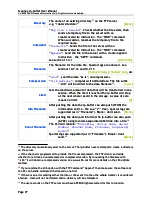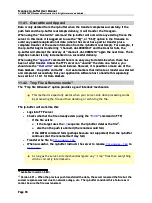
Scannex ip.buffer User Manual
© UK 2007-2021 Scannex Electronics Ltd. All rights reserved worldwide.
Client Type
“
Auto (Telnet/Raw)
” – if the client software negotiates
Telnet options then we send back further Telnet options.
“
Telnet
” – The ip.buffer sends Telnet options when the client
connects. This is necessary when a Linux telnet command
is used to connect to a non-standard port.
“
Raw TCP/IP
” – No Telnet options. Every byte is transferred
without modification between source and pass-through.
[Auto (Telnet/Raw)]
Authenticate
“
No
” – If the remote end needs authentication, the details will be
passed to the Source.
“
Wait/Send
” – If the remote end needs authentication, the
password will be sent from the ip.buffer (and the Source
will not have to worry)
[No]
Prompt
The prompt message when a password is required
[Password:]
Password
A simple password string. When the client connects to the
passthrough TCP/IP socket they will be asked for the
password
When a successful password is entered, the ip.buffer will send
back “OK” (CR/LF) to the client.
“blank” = no password checking
[password]
Success
The string to send when the password is successfull.
[OK\r\n]
Mode
“
Not Stored
” – When connected, the pass-through has
exclusive access to the source port. Nothing received from
the source is stored.
“
Stored
” – When connected, the pass-through can read and
write to the source port (and the channel's protocol is
prevented from writing to the source port). All data from
the source is passed through to the protocol section for
storage.
“
Monitor
” – the pass-through is read-only. Additionally the pass-
through socket can be connected even when the source is
not connected.
“
Debug
” – The pass-through is read-only and presents debugging
information in a packetised format (for use with a PC
application to show the data between source and
protocol).
[Not stored]
While connected, the text “
passthru
” will appear under the source name in the web
status page.
44
Only applicable to an active passthrough connection
45
If you want to
always
send the prompt, even if the password entry is blank, then prefix the string
with an exclamation mark “!”.
46
Only a single CR is required to finalise the password entry. If the client sends CR + LF, then the
single LF will be consumed (ignored).
Page 89
Scannex ip.buffer User Manual
© UK 2007-2021 Scannex Electronics Ltd. All rights reserved worldwide.
Client Type
“
Auto (Telnet/Raw)
” – if the client software negotiates
Telnet options then we send back further Telnet options.
“
Telnet
” – The ip.buffer sends Telnet options when the client
connects. This is necessary when a Linux telnet command
is used to connect to a non-standard port.
“
Raw TCP/IP
” – No Telnet options. Every byte is transferred
without modification between source and pass-through.
[Auto (Telnet/Raw)]
Authenticate
“
No
” – If the remote end needs authentication, the details will be
passed to the Source.
“
Wait/Send
” – If the remote end needs authentication, the
password will be sent from the ip.buffer (and the Source
will not have to worry)
[No]
Prompt
The prompt message when a password is required
[Password:]
Password
A simple password string. When the client connects to the
passthrough TCP/IP socket they will be asked for the
password
When a successful password is entered, the ip.buffer will send
back “OK” (CR/LF) to the client.
“blank” = no password checking
[password]
Success
The string to send when the password is successfull.
[OK\r\n]
Mode
“
Not Stored
” – When connected, the pass-through has
exclusive access to the source port. Nothing received from
the source is stored.
“
Stored
” – When connected, the pass-through can read and
write to the source port (and the channel's protocol is
prevented from writing to the source port). All data from
the source is passed through to the protocol section for
storage.
“
Monitor
” – the pass-through is read-only. Additionally the pass-
through socket can be connected even when the source is
not connected.
“
Debug
” – The pass-through is read-only and presents debugging
information in a packetised format (for use with a PC
application to show the data between source and
protocol).
[Not stored]
While connected, the text “
passthru
” will appear under the source name in the web
status page.
44
Only applicable to an active passthrough connection
45
If you want to
always
send the prompt, even if the password entry is blank, then prefix the string
with an exclamation mark “!”.
46
Only a single CR is required to finalise the password entry. If the client sends CR + LF, then the
single LF will be consumed (ignored).
Page 89
















































